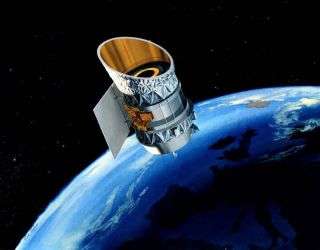
The The Infrared Astronomical Satellite (IRAS) orbits the Earth in this illustration.
Two defunct satellites will zip past each other at 32,800 mph (14.7 kilometers per second) in the sky over Pittsburgh on Wednesday evening (Jan. 29). If the two satellites were to collide, the debris could endanger spacecraft around the planet.
It will be a near miss: LeoLabs, the satellite-tracking company that made the prediction, said they should pass between 50 feet and 100 feet apart (15 to 30 meters) at 6:39:35 p.m. local time.
One is called the Infrared Astronomical Satellite (IRAS). Launched in 1983, it was the first infrared space telescope and operated for less than a year, according to the Jet Propulsion Laboratory. The other is called the Gravity Gradient Stabilization Experiment (GGSE-4), and was a U.S. Air Force experiment launched in 1967 to test spacecraft design principles, according to NASA. The two satellites are unlikely to actually slam into each other, said LeoLabs CEO Dan Ceperley. But predictions of the precise movements of fairly small, fast objects over vast distances is a challenge, Ceperley told Live Science. (LeoLabs’ business model is selling improvements on those predictions.)
If they did collide, “there would be thousands of pieces of new debris that would stay in orbit for decades. Those new clouds of debris would threaten any satellites operating near the collision altitude and any spacecraft transiting through on its way to other destinations. The new debris [would] spread out and form a debris belt around the Earth,” Ceperley said.
LeoLabs uses its own network of ground-based radar to track orbiting objects. Still, Jonathan McDowell, a Harvard-Smithsonian Center for Astrophysics astronomer who tracks satellites using public data, said the near-miss prediction was plausible.
“I confirm there is a close approach of these two satellites around 2339 UTC Jan 29. How close isn’t clear from the data I have, but it’s reasonable that LEOLabs data is better,” McDowell told Live Science.
(When it’s 23:39 UTC it’s 6:39 p.m. Eastern time, which is the time zone in Pittsburgh.)
“What’s different here is that this isn’t debris-on-payload but payload-on-payload,” McDowell said. In other words, in this case two satellites, rather than debris and a satellite, are coming close to one another.
It’s pretty common for bits of orbital debris to have near misses in orbit, Ceperley said, which usually go untracked. It’s more unusual, though, for two full-size satellites to come this close in space. IRAS in particular is the size of a truck, at 11.8 feet by 10.6 feet by 6.7 feet (3.6 by 3.2 by 2.1 m).
“Events like this highlight the need for responsible, timely deorbiting of satellites for space sustainability moving forward. We will continue to monitor this event through the coming days and provide updates as available,” LeoLabs said on Twitter.
Editor’s note: This story has been corrected. Jan. 29 is Wednesday, not Thursday.
Sourse: www.livescience.com





